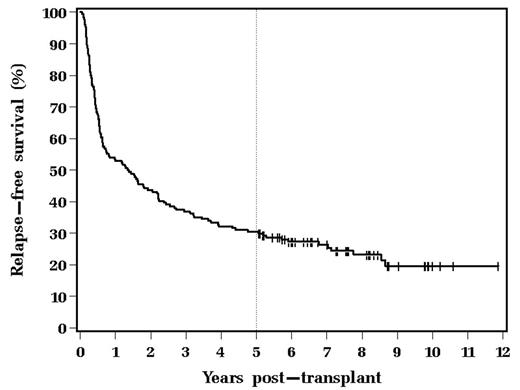Abstract
Autologous stem cell transplantation (ASCT) is the treatment of choice for patients with relapsed/refractory DLBCL. ASCT is widely quoted as being potentially curative. We queried whether surviving patients free of disease five years after transplant were still at ongoing risk for relapse or other adverse events. We therefore retrospectively reviewed 174 patients with DLBCL receiving an ASCT from 1/1992 through 12/2001 who have been followed for at least 5 years since the date of transplant. Of these, 121 relapsed or died within the first 5 years of transplant; 42 are alive without disease greater than 5 years after transplant; and 11 relapsed or died greater than 5 years post-transplant. The median follow up among survivors is 7.3 years. Among the 11 patients with late events, 3 experienced non-relapse mortality: one died of secondary malignancy 104 months post-transplant; one died in a car accident 62 months post-transplant; one committed suicide 93 months post-transplant. Eight patients relapsed beyond 5 years from transplant: 3 have died and 5 are still alive. The three patients who expired from their relapse did so at 0.4, 2.5 and 23.2 months after relapse. Five patients relapsed between 63 and 102 months post-transplant and remain alive 6–72 months later. Two demographic trends were of interest: patients experiencing late adverse events were more likely to have bone marrow involvement at diagnosis, as 36% of patients with late events had marrow involvement at diagnosis as compared to 19% who remain alive and disease free; and of patients alive and disease free 5+ years post-transplant, 67% are male and 33% are female; of patients with late adverse events, 45% are male and 55% are female. The relapse-free survival curve for the entire patient cohort is shown below:
We conclude that there is a low, but detectable, risk of disease relapse that continues beyond 5 years after ASCT for DLBCL. However, in this series the majority of patients experiencing delayed relapse remain alive with additional therapy. This underscores the importance of extended ongoing follow up for DLBCL patients treated with ASCT.
Disclosure: No relevant conflicts of interest to declare.
Author notes
Corresponding author


This feature is available to Subscribers Only
Sign In or Create an Account Close Modal